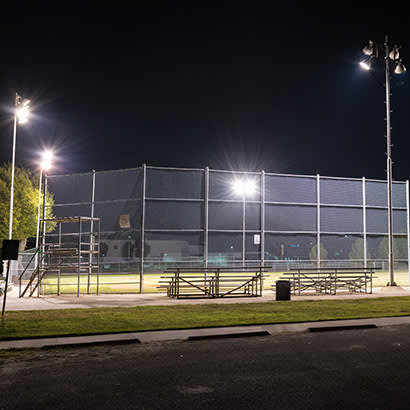
As society continues to quickly urbanize, the issue of light pollution increases across the globe. This excess output of light from buildings, streetlamps, and sports stadiums and fields is not only a nuisance, but also a culprit that wastes energy, disrupts ecosystems, alters wildlife behavior and has detrimental effects on human health.
Some of the contributors of light pollution are sports fields and stadiums. And, according to the International Dark-Sky Association (IDA), “In the [United States] alone, it is estimated that more than 2,000 outdoor sports lighting complexes are either retrofitted or installed every year.” Many of the newly created fixtures are installed at schools, parks and neighborhood complexes. For residents in these areas, spill light (light that travels beyond its intended space and illuminates excess area) and glare (excessively bright light that reduces the ability to see) prove to be common and recurring issues. While these are the primary points of contention for neighbors of sports fields, skyglow (light that is scattered into the atmosphere) can extend farther distances and affect ecosystems and wildlife habitats.
To address the role that sports lighting plays in the increasing issue of light pollution, IDA has developed criteria for community-friendly outdoor sports lighting. By adhering to IDA’s criteria, “…communities demonstrate and promote the vision for outdoor sports lighting that simultaneously meets the demanding task of illuminating nighttime sports events while preserving the night skies,” the organization states.
In recent years, many manufacturers have worked to develop lighting systems that are more effective for their intended purpose while eliminating many of the undesired effects. These solutions include:
- Fully shielded lighting fixtures, which prevent light from traveling upward from the source
- Switching to LEDs, which conserve energy and offer more control and precision than traditional incandescent lights
- Automation or control systems that allow lights to be turned off at a pre-selected curfew time
- The minimization of blue wavelengths that can affect human sleep cycles by suppressing melatonin, a hormone that regulates the sleep-wake cycle
In addition, Fairfax County Park Authority in Virginia produced a report that outlines many of the issues involved with controlling light pollution and offers recommendations for tackling the problem, including:
- Adhering to the International Commission of Illumination’s guidelines for light source intensity
- Considering shielding, reflectors, wattages, beam types, mounting height and aiming angles, which each influence the amount of glare produced
- Taking advantage of natural screening when possible
- Using timers, sensors and controllers to keep light from unnecessarily entering neighboring spaces
- Closely supervising scheduling and field use to ensure that lights are not left on when not in use
Taking time to assess your sports field lighting to ensure adherence to industry standards can reduce your costs and energy production and improve nighttime conditions in your community while limiting your impact on the night sky.
Lindsay Collins is Associate Editor for Parks & Recreation magazine.

